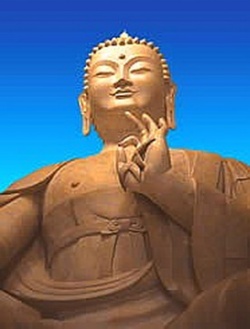Madhyamika
Madhyamika (Skt. Mādhyamika; Tib. དབུ་མ་པ་>, umapa; Wyl. dbu ma pa) — the followers of the Middle Way philosophy, which teaches freedom from all extremes.
They say that just as truly existent external phenomena were refuted by the Chittamatra school, a truly existent perceiving mind must also be refuted, since both are equally lacking in inherent existence, being mere dependent originations.
The Madhyamika school originates with Nagarjuna, who commented upon the direct meaning of the Prajñaparamita sutras in his Collection of Reasoning, which includes the famous Root Verses on the Middle Way.
(skt.: madhyamika; tib.: uma) It is a system founded by Nagarjuna in the second century C.E., based on the Prajnaparamita Sutras of Shakyamuni Buddha, and considered to be the supreme presentation of the wisdom of emptiness.
Madhyamika (S): Tibetan: Uma. Middle Way. A philosophical school based on the Prajnaparamita Sutras and their doctrine of Emptiness; the Middle Way philosophy expounded by Nagarjuna.
The Madhyamika is concerned both with the transcendence of logical affirmation and negation, and stresses the dependent origination of all things and the limitations of rational constructs. It represents a great philosophical tradition of Mahayana buddhism, which was expounded in detail by the great Master Nagarjuna, which adopts a middle position between two extreme views of eternalism and nihilism. Madhyamika is a response to essential questions concerning the existence or the nonexistence of things (phenomena) as well as beings.
Nagarjuna states that in the final analysis of any conventionally established object, it is an error either to affirm or deny its existence, nonexistence, to say it possess attributes of the two at the same time, or neither, are all insufficient to describe its true nature.
To claim otherwise is an extreme view which is a symptom of ego-clinging to the assumption of inherent existence.
Since the Buddha taught the emptiness of appearance, nowhere will one find substance, essence or ontological foundation; with proper analysis, the problem disappears on its own since there is no further referenceto an ego or real things. Nagarjuna equated emptiness with interdependent origination, thecausally-conditioned, relative nature of all compounded phenomena.
He posited two levels of truth, the absolute and the conventional. His immediate disciple Aryadeva carried on his teaching.
About A.D. 500 Bhavaviveka, heading the Svatantrika school of the Madhyamika, held that the Buddhist position can be put forward by positive argument. The Prasanga school, championed by Chandrakirti, opposed him and reaffirmed the simple refutation of opponents by reductio ad absurdum as the true Madhyamika position.
This view holds that all phenomena are empty of self existance and that they arise by dependant origination.
It is called middle way because it avoids the two mistaken extremes (so it is in the middle of these two extremes):
1. seeing things as self existent (eternalism)
2. seeing things as non existent (nihilism)
Madhyamika is divided in two schools:
1. Madhyamika Svatantrika (uma rang gyu pa): view that still holds that things have some kind of self existence. This view is considered as lower than Madhyamika Prasangika.
2. Madhyamika Prasangika (uma ten gyur pa): view that holds that nothing at all has any kind of self existence. This view is considered supreme.
Subschools
There are two ‘schools’ or streams within the Madhyamika: the Svatantrika and the Prasangika.
These two approaches came about when two Indian masters wrote slightly different commentaries to Nagarjuna’s Root Verses text.
Buddhapalita insisted that the followers of Madhyamika should not make any independent assertions, but merely show the absurd consequences of holding to any extreme position.
This approach is called prasangika, meaning “consequence”.
The other, Bhavaviveka, thought it was acceptable to use what is called “autonomous syllogism” (svatantra).
This approach is called svatantrika.
Madhyamika or Madhyamaka?
There has been some disagreement in Western scholarship on the use of the terms Madhyamaka and Madhyamika.
Great Sanskritists such as T. R. V. Murti, a member of the Sanskrit Commission set up by the Indian government in 1959, advocated the use of "Madhyamika" on all occasions.
Others use Madhyamaka for the system and the texts, and Madhyamika for its advocates.
Mādhyamika, (Sanskrit: “Intermediate”), important school in the Mahāyāna (“Great Vehicle”) Buddhist tradition.
Its name derives from its having sought a middle position between the realism of the Sarvāstivāda (“Doctrine That All Is Real”) school and the idealism of the Yogācāra (“Mind Only”) school.
The most renowned Mādhyamika thinker was Nāgārjuna (2nd century ad), who developed the doctrine that all is void (śūnyavāda).
The three authoritative texts of the school are the Mādhyamika-śāstra (Sanskrit: “Treatise of the Middle Way”) and the Dvādasá-dvāra-śāstra (“Twelve Gates Treatise”) by Nāgārjuna and the Śataka-śāstra (“One Hundred Verses Treatise”), attributed to his pupil Āryadeva.
Buddhism in general assumed that the world is a cosmic flux of momentary interconnected events (dharmas), however the reality of these events might be viewed.
Nāgārjuna sought to demonstrate that the flux itself could not be held to be real, nor could the consciousness perceiving it, as it itself is part of this flux.
If this world of constant change is not real, neither can the serial transmigration be real, nor its opposite, nirvana.
Transmigration and nirvana being equally unreal, they are one and the same.
In the final analysis, reality can only be attributed to something entirely different from all that is known, which must therefore have no identifiable predicates and can only be styled the void (sunyata).
Mādhyamika thinkers thus strongly emphasize the mutations of human consciousness to grasp the reality of that which is ultimately real beyond any duality.
The world of duality could be assigned a practical reality of vyavahāra (“discourse and process”), but, once the ultimate meaning (paramārtha) of the void is grasped, this reality falls away.
These ideals influenced Hindu thinkers, principally Gauḍapāda (7th century) and Śaṅkara (usually dated ad 788–820); the latter is therefore called a crypto-Mādhyamika by his adversaries.
The basic Mādhyamika texts were translated into Chinese by Kumārajiva in the 5th century, and the teachings were further systematized (as the San-lun, or Three Treatises, school) in the 6th–7th century by Chi-tsang.
The school spread to Korea and was first transmitted to Japan, as Sanron, in 625 by the Korean monk Ekwan.

